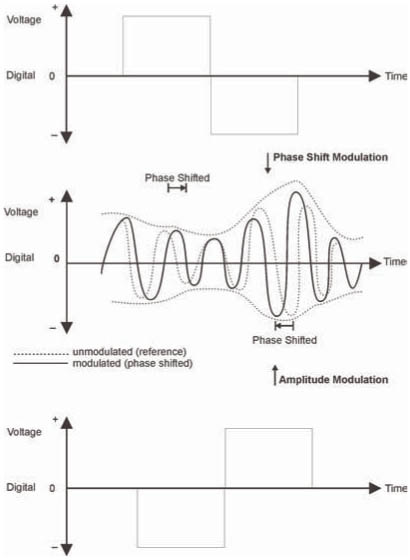Modulation is the process of changing the amplitude, frequency, or phase of a radio frequency carrier signal with the information signal (such as voice or data). The 802.16 system uses different types of digital modulation depending on a variety of transmission factors. The modulation types used in 802.16 systems include binary phase shift keying (BPSK), quadrature phase shift keying (QPSK) and quadrature amplitude modulation (QAM).
Binary Phase Shift Keying (BPSK)
Binary phase shift keying (BPSK) is a modulation process that converts binary bits into phase shifts of the radio carrier without substantially changing the frequency of the carrier waveform. The phase of a carrier is the relative time of the peaks and valleys of the sine wave relative to the time of an unmodulated “clock” sine wave of the same frequency. BPSK uses only twophase angles, corresponding to a phase shift of zero or a half cycle (zero or 180 degrees of angle). WiMAX uses BPSK modulation when a very robust signal is required.
Quadrature Phase Shift Keying (QPSK)
Quadrature phase shift keying (QPSK) is a type of modulation that uses 4 different phase shifts of a radio carrier signal to represent the digital information signal. These shifts are typically +/- 45 and +/- 135 degrees.
Quadrature Amplitude Modulation (QAM)
QAM is a combination of amplitude modulation (changing the amplitude or voltage of a sine wave to convey information) together with phase modulation. There are several ways to build a QAM modulator. In one process, two modulating signals are derived by special pre-processing from the information bit stream. Two replicas of the carrier frequency sine wave are generated; one is a direct replica and the other is delayed by a quarter of a cycle (90 degrees). Each of the two different derived modulating signals are then used to amplitude modulate one of the two replica carrier sinewaves respectively. The resultant two modulated signals can be added together. The result is a sine wave having a constant unchanging frequency while having an amplitude and phase that both vary to convey the information. At the detector or decoder the original information bit stream can be reconstructed. QAM conveys a higher information bit rate (bits per second) than a BPSK or QPSK signal of the same bandwidth, but is also more affected by interference and noise.
Figure 1 shows that amplitude and phase modulation (QAM) can be combined to form an efficient modulation system. One digital signal changes the phase and another digital signal changes the amplitude.
Adaptive Modulation
Adaptive modulation is the process of dynamically adjusting the modulation type of a communication channel based on specific criteria (e.g. interference or data transmission rate). WiMAX systems use adaptive modulation to ensure the modulation type matches the channel characteristics (signal quality level).
In general, the more efficient (data transmission capacity) the modulation type, the more complex or precise the modulation process is. The more precise the modulation process (smaller changes represent digital bits), the more sensitive the modulation is to distortion or interference. This usually means that as the data transmission rate increases, the sensitivity to interference intensifies. To help manage this process and ensure the maximum data transmission rate possible, 802.16 systems automatically change their data modulation types and data transmission rates (Autorate) based on the ability of the channel to transfer data. The 802.16 systems will usually try to send information at the highest data transmission rate possible. If the data transmission rate cannot be maintained, the 802.16 systems will attempt to transmit at the next lower data transmission rate. Lower data transmission rates generally use a less complex (more robust) modulation type.



No comments:
Post a Comment